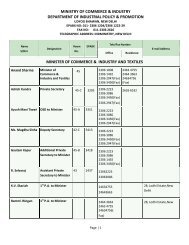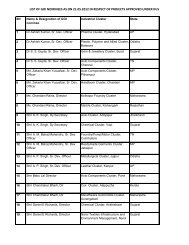fdi in india and its growth linkages - Department Of Industrial Policy ...
fdi in india and its growth linkages - Department Of Industrial Policy ...
fdi in india and its growth linkages - Department Of Industrial Policy ...
Create successful ePaper yourself
Turn your PDF publications into a flip-book with our unique Google optimized e-Paper software.
Chapter 6: Secondary Data-Based Analysis<br />
6.1 Backdrop<br />
The study is based on the Capital<strong>in</strong>e database. 1 It provides fundamental <strong>and</strong> market data on over 14,000 Indian listed<br />
<strong>and</strong> unlisted companies classified under more than 300 <strong>in</strong>dustries. It conta<strong>in</strong>s <strong>in</strong>formation on company profile, f<strong>in</strong>ancial<br />
<strong>in</strong>dicators, ownership patterns, f<strong>in</strong>ished products, exports, raw materials <strong>and</strong> other details. Apart from the firm-level<br />
<strong>in</strong>formation, the Capital<strong>in</strong>e database also provides the addresses of all the plants of the company along with the products<br />
manufactured. 2<br />
There is a debate on the cut-off percentage of foreign equity stake required for a firm to be classified as an FDI-enabled<br />
firm or as an FDI firm. We have considered all firms with foreign equity participation of 10 per cent <strong>and</strong> above to be<br />
“FDI firms”; these <strong>in</strong>clude both domestic firms, with more than 10 per cent foreign equity, as well as foreign/MNC<br />
firms. 3 All other firms, with less than 10 per cent foreign equity, are referred to as “domestic firms”. The analsyis, based<br />
on secondary data, has been undertaken to cover the issues of a) spatial spread <strong>and</strong> <strong>its</strong> reasons; b) sectoral cluster<strong>in</strong>g; c)<br />
depth of value-added; d) employment generat<strong>in</strong>g effects; e) labour <strong>and</strong> capital <strong>in</strong>tensity; f ) comparative performance of<br />
FDI firms <strong>and</strong> domestic firms; <strong>and</strong> g) export potential.<br />
Based on the data compiled <strong>in</strong> the Population Census 2001, cities/towns have been grouped <strong>in</strong>to three classes based on<br />
size. Class-1 cities are towns with a population of 10,00,000 (one million) <strong>and</strong> above, Class-2 cities are towns with a<br />
population between 5,00,000 <strong>and</strong> 10,00,000, <strong>and</strong> Class-3 cities are towns with a population of less than 5,00,000. For<br />
uniformity, we have used the term “city” <strong>and</strong> not “town” <strong>in</strong> our report. Thus the spatial distribution of manufactur<strong>in</strong>g<br />
firms is captured through the distribution of plants <strong>and</strong> facilities of FDI <strong>and</strong> domestic firms across states <strong>and</strong> across cities<br />
of various classes with<strong>in</strong> states. It is assumed that Class-1 <strong>and</strong> Class-2 cities are relatively more developed vis-à-vis<br />
Class-3 cities, which are likely to be suburban towns that are closer to rural areas of the country. The purpose of<br />
<strong>in</strong>troduc<strong>in</strong>g city-size classes is to locate the movement <strong>and</strong> f<strong>in</strong>al plant location of FDI firms. The greater the amount of<br />
FDI that moves <strong>in</strong>to Class-3 cities, the higher <strong>its</strong> l<strong>in</strong>kage with the suburban/ rural economy of the country. 4<br />
In our analysis of the secondary data, we have adopted a dual methodology which is given as follows:<br />
1. Spatial spread: The <strong>in</strong>formation of firms/plants, both FDI <strong>and</strong> domestic, has been used for the period March 1999<br />
to September 2008, based on the latest reported data, <strong>in</strong> order to analyse the spatial spread of the firms plants over<br />
a period of time; <strong>and</strong><br />
2. Current Scenario: The data of FDI firms/plants for a more recent period have been used to gauge the current<br />
economic performance of these firms/plants. The period April 2006 – September 2008 has been used as the period<br />
of reference to cull the latest reported f<strong>in</strong>ancial <strong>and</strong> operative data. This is done because Capital<strong>in</strong>e cannot report<br />
data for all firms at a s<strong>in</strong>gle po<strong>in</strong>t of time, say March 2008, s<strong>in</strong>ce it receives f<strong>in</strong>ancial reports of the firms at different<br />
1. http://www.capital<strong>in</strong>e.com/new/plus.asp<br />
2. Prowess is an alternative database but does not provide <strong>in</strong>formation on plant location.<br />
3. IMF (1996). Balance of Payments Textbook, page 108.<br />
4. As a follow-up to our discussion with DIPP, the major focus of our analysis has been on manufactur<strong>in</strong>g sectors. However, we have also provided descriptive<br />
features of FDI-enabled firms <strong>in</strong> service sectors <strong>in</strong> data tables of this chapter. While the penetration of foreign equity, fixed capital, employment <strong>and</strong> output<br />
of the FDI manufactur<strong>in</strong>g plants is relatively deep <strong>in</strong> Class-3 cities (around 45 per cent for each category), the same is not true of the penetration of FDI<br />
facilities <strong>in</strong> service sectors with correspond<strong>in</strong>g shares hover<strong>in</strong>g around 10 per cent. Thus, the reach of the FDI manufactur<strong>in</strong>g plants <strong>in</strong>to Class-3 cities is<br />
much higher than that of FDI firms <strong>in</strong> services.<br />
57












